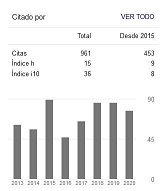Behavior, performance and carcass yield of steers with different comfort conditioning during the fattening period
Resumen
Objective. The aim of this study was to evaluate the behavior and performance of steers in two different housing areas (10 vs. 100 m2/animal) and two feeding models (daily supply vs. self-feeding) during the fattening period. Materials and methods: Forty-eight Hereford steers with initial live weight (LW): 214,0 kg were housed under four treatments: 100DS (100 m2/animal and daily supply), 100SF (100 m2/animal and self-feeding), 10DS (10 m2/animal and daily supply), 10SF (10 m2/animal and self-feeding) until reaching a final LW of 370 390 kg. Behavior was recorded by observation. Dry matter intake (DMI) and average daily gain (ADG) were recorded to estimate feed conversion ratio (FCR). Back fat thickness (BFT) and Longissimus muscle area (LMA) were measured. Steers were sent to a commercial abattoir to evaluate carcass yield. Results: The frequency of rest and walking was higher in steers in the largest housing area. Self-feeding contributed to the intake distribution during the day. No differences were detected in DMI, ADG and FCR. However, the confined animals (10DS and 10SF) produced more BFT and less LMA. In addition, they had less carcass yield at slaughter. Conclusions: Therefore, a larger housing area and the self-feeding model could contribute to express steers natural behavior and improve their performance.
KEYWORDS: animal welfare, cattle, feedlot, housing area, feeding (Source: MESH)
Descargas
Citas
Chen, Y., Arsenault, R., Napper, S., & Griebel, P. (2015). Models and methods to investigate acute stress responses in cattle. Animals, 5(4), 1268-1295. https://www.mdpi.com/2076-2615/5/4/411
De Souza Teixeira, O., Brondani, I. L., Alves Filho, D. C., Nörnberg, J. L., Cattelam, J., Pereira, L. B., & Klein, J. L. (2018). Performance and ingestive and social behavior of young cattle with different sexual conditions supplemented in Aruana pasture. Semina: Ciências Agrárias, 39(6), 2565-2580. https://ojs.uel.br/revistas/uel/index.php/semagrarias/article/view/31105
Dunston-Clarke, E. J., Hunter, I., & Collins, T. (2020). Influence of Exercise Enrichment on Feedlot Cattle Behaviour and the Human–Animal Relationship. Proceedings, 73 (4), 2-7. https://www.mdpi.com/2504-3900/73/1/4
Fernandez-Novo, A., Pérez-Garnelo, S. S., Villagrá, A., Pérez-Villalobos, N., & Astiz, S. (2020). The effect of stress on reproduction and reproductive technologies in beef cattle—A review. Animals, 10(11), 2096. https://www.mdpi.com/2076-2615/10/11/2096
González, L. A., Manteca, X., Calsamiglia, S., Schwartzkopf-Genswein, K. S., & Ferret, A. (2012). Ruminal acidosis in feedlot cattle: Interplay between feed ingredients, rumen function and feeding behavior (a review). Animal feed science and technology, 172(1-2), 66-79. https://www.sciencedirect.com/science/article/abs/pii/S0377840111004986
Grandin, T. (2016). Evaluation of the welfare of cattle housed in outdoor feedlot pens. Veterinary and Animal Science, 1, 23-28. https://www.sciencedirect.com/science/article/pii/S2451943X16300278
Grandin, T. (2022). Practical Application of the Five Domains Animal Welfare Framework for Supply Food Animal Chain Managers. Animals, 12(20), 2831. https://www.mdpi.com/2076-2615/12/20/2831
Macitelli, F., Braga, J. S., Gellatly, D., & da Costa, M. P. (2020). Reduced space in outdoor feedlot impacts beef cattle welfare. animal, 14(12), 2588-2597. https://www.cambridge.org/core/journals/animal/article/abs/reduced-space-in-outdoor-feedlot-impacts-beef-cattle-welfare/C94CC107B54CF37A185357B23BE9B1FD
Mader, T. L., & Griffin, D. (2015). Management of cattle exposed to adverse environmental conditions. Veterinary Clinics: Food Animal Practice, 31(2), 247-258. https://www.vetfood.theclinics.com/article/S0749-0720(15)00021-3/fulltext
Mader, T. L., & Colgan, S. L. (2007). Pen density and straw bedding during feedlot finishing. Nebraska Beef Cattle Reports, 70, 43-46. https://digitalcommons.unl.edu/animalscinbcr/70/
Mattachini, G., Riva, E., Pompe, J. C. A. M., Bisaglia, C., & Provolo, G. (2011). Methods for measuring the behaviour of dairy cows in free stall barns. https://library.wur.nl/WebQuery/wurpubs/fulltext/195362
Mellor, D. J., Beausoleil, N. J., Littlewood, K. E., McLean, A. N., McGreevy, P. D., Jones, B., & Wilkins, C. (2020). The 2020 five domains model: Including human–animal interactions in assessments of animal welfare. Animals, 10(10), 1870. https://www.mdpi.com/2076-2615/10/10/1870
Mota, R. G., & Marcal, W. S. (2019). Comportamento e bem-estar animal de bovinos confinados: Alternativas para uma produção eficiente, rentável e de qualidade: Revisão bibliográfica. Revista Brasileira de Higiene e Sanidade Animal: RBHSA, 13(1), 125-141. https://dialnet.unirioja.es/servlet/articulo?codigo=6997432
Neave, H. W., Schütz, K. E., & Dalley, D. E. (2022). Behavior of dairy cows managed outdoors in winter: Effects of weather and paddock soil conditions. Journal of Dairy Science, 105(10), 8298-8315. https://www.sciencedirect.com/science/article/pii/S0022030222004404
Oberschätzl-Kopp, R., Haidn, B., Peis, R., Reiter, K., & Bernhardt, H. (2016, June). Effects of an automatic feeding system with dynamic feed delivery times on the behaviour of dairy cows. In Proc. of CIGR-AgEng 2016 Conference, Aarhus, Denmark (pp. 1-8). https://www.cabdirect.org/cabdirect/abstract/20183376882
Park, R. M., Foster, M., & Daigle, C. L. (2020). A scoping review: The impact of housing systems and environmental features on beef cattle welfare. Animals, 10(4), 565. https://www.mdpi.com/2076-2615/10/4/565
Pordomingo, A. J., Gelid, L., Pordomingo, A. B., Baliño, P., & Bressan, E. (2022). Uso de monensina y virginiamicina en el engorde a corral de vaquillonas basado en maíz entero. RIA. Revista de investigaciones agropecuarias, 48(1), 71-77. http://www.scielo.org.ar/scielo.php?pid=S1669-23142022000100071&script=sci_arttext
Rossanigo, C. E., Bengolea, A., & Sager, R. L. (2009). Enfermedades bovinas en los sistemas intensivos de la región semiárida-subhúmeda central. Revista Argentina de Producción Animal, 29(2), 151-180. https://www.researchgate.net/publication/264544414_Enfermedades_bovinas_en_los_sistemas_intensivos_de_la_region_semiarida-subhumeda_central
Schneider, L., Kemper, N., & Spindler, B. (2019). Stereotypic behavior in fattening bulls. Animals, 10(1), 40. https://www.mdpi.com/2076-2615/10/1/40
Schütz, K. E., Cave, V. M., Cox, N. R., Huddart, F. J., & Tucker, C. B. (2019). Effects of 3 surface types on dairy cattle behavior, preference, and hygiene. Journal of dairy science, 102(2), 1530-1541. https://www.sciencedirect.com/science/article/pii/S0022030218311159
Derechos de autor 2023 Revista de Producción Animal

Esta obra está bajo licencia internacional Creative Commons Reconocimiento-NoComercial 4.0.
Los autores de los artículos publicados en RPA retienen los derechos de autor de su trabajo, de marca y patente, y también sobre cualquier proceso o procedimiento descrito en el artículo, así como a compartir, copiar, distribuir, ejecutar y comunicar públicamente el artículo publicado en la RPA o cualquier parte de aquel siempre que indiquen la fuente de publicación (autores del trabajo, revista, volumen, número y fecha), pero están de acuerdo en que la revista publique los trabajos bajo una licencia Creative Commons.
![]() Licencia Attribution-NonCommercial 4.0 International (CC BY-NC 4.0)
Licencia Attribution-NonCommercial 4.0 International (CC BY-NC 4.0)






































